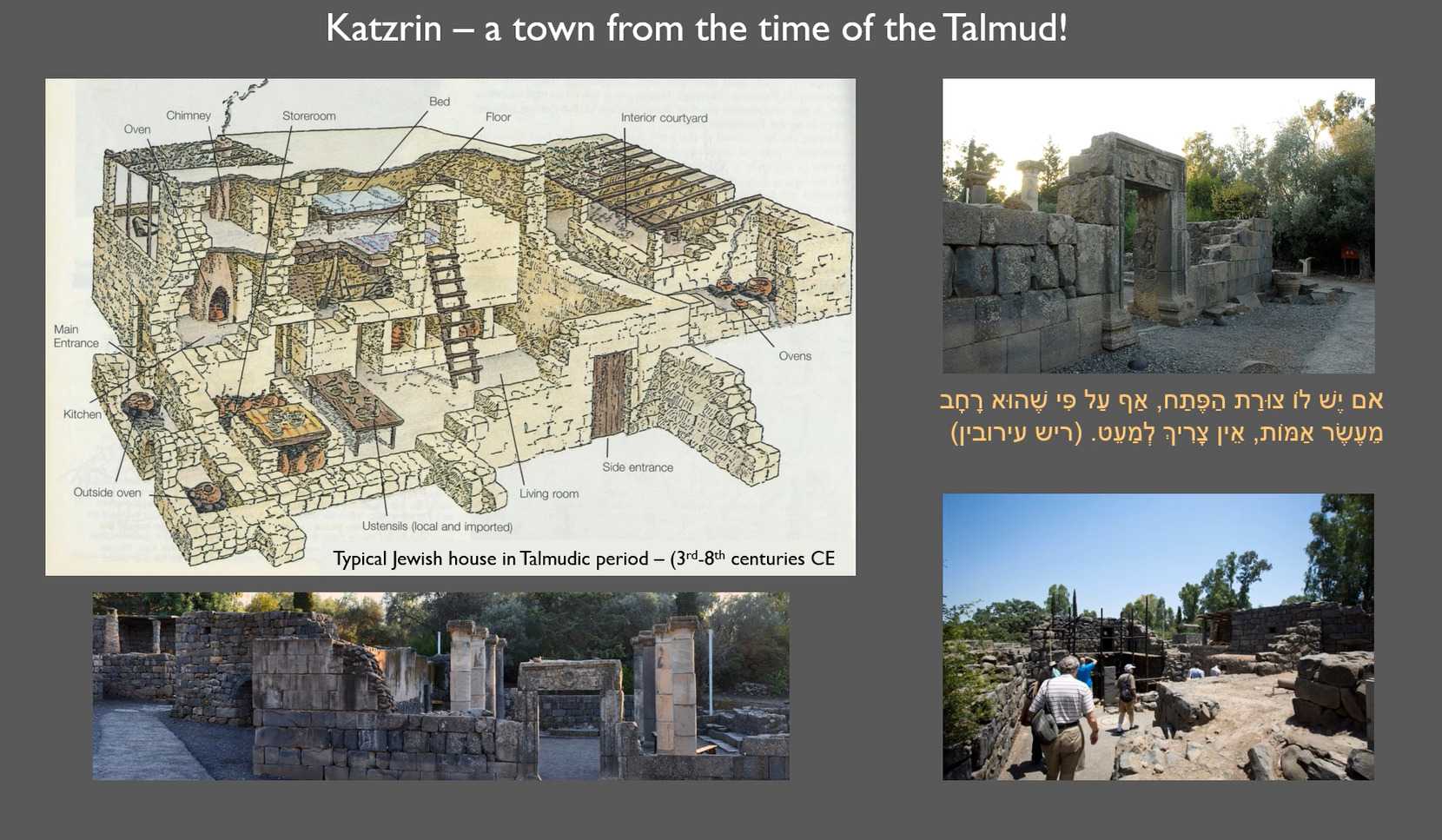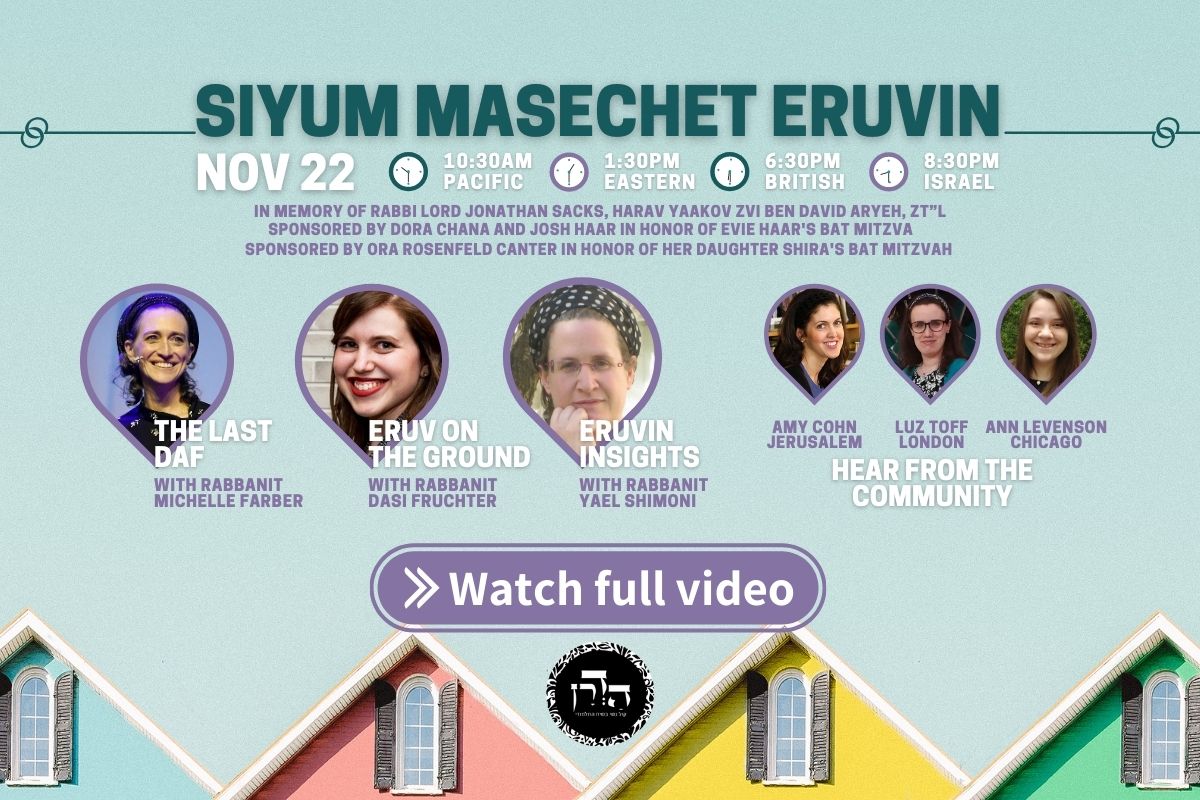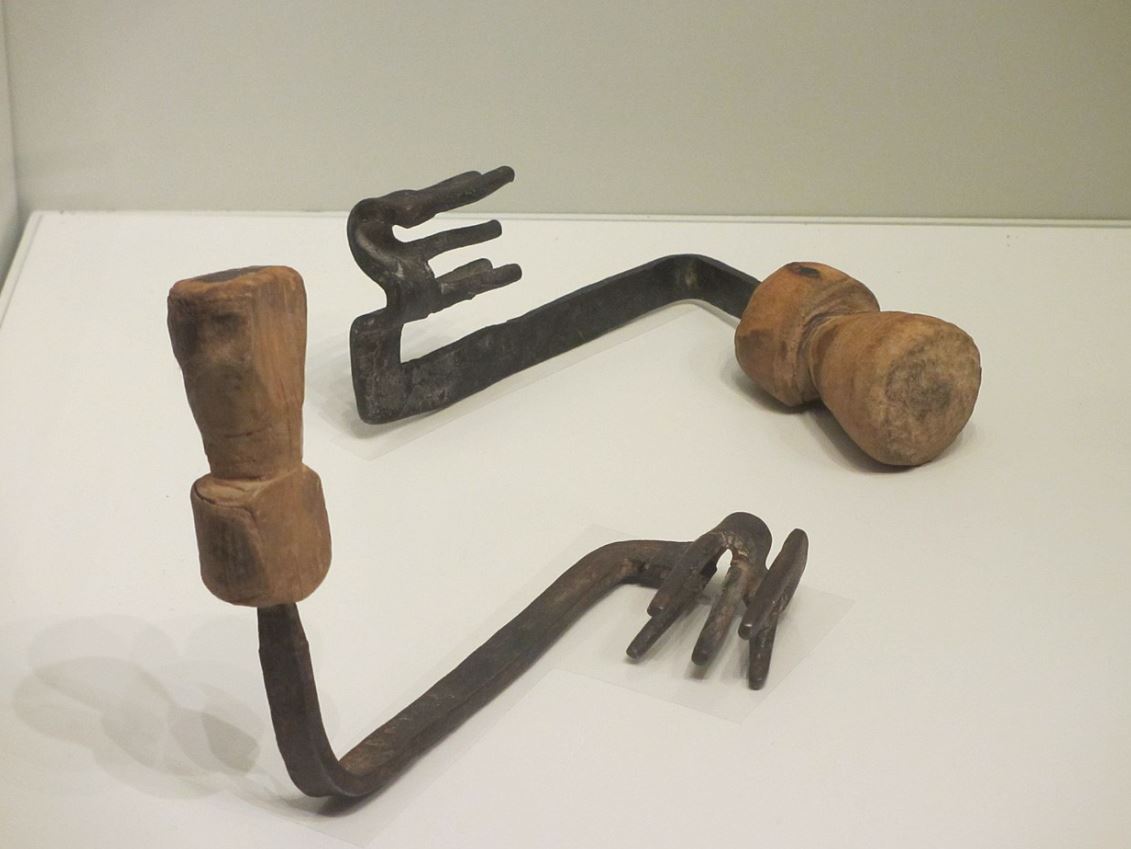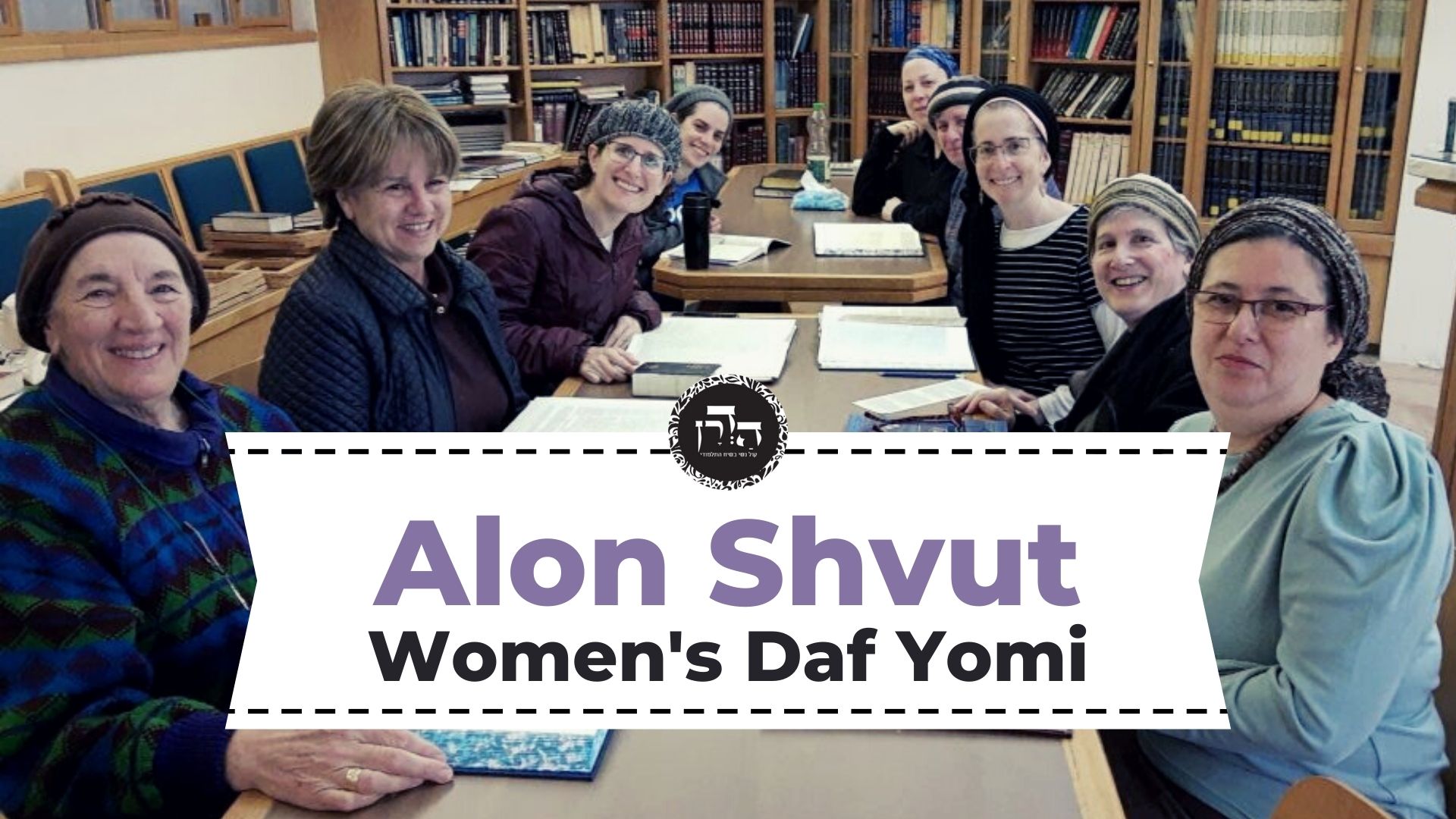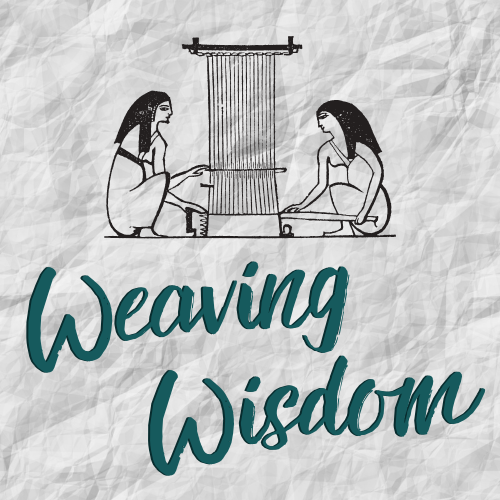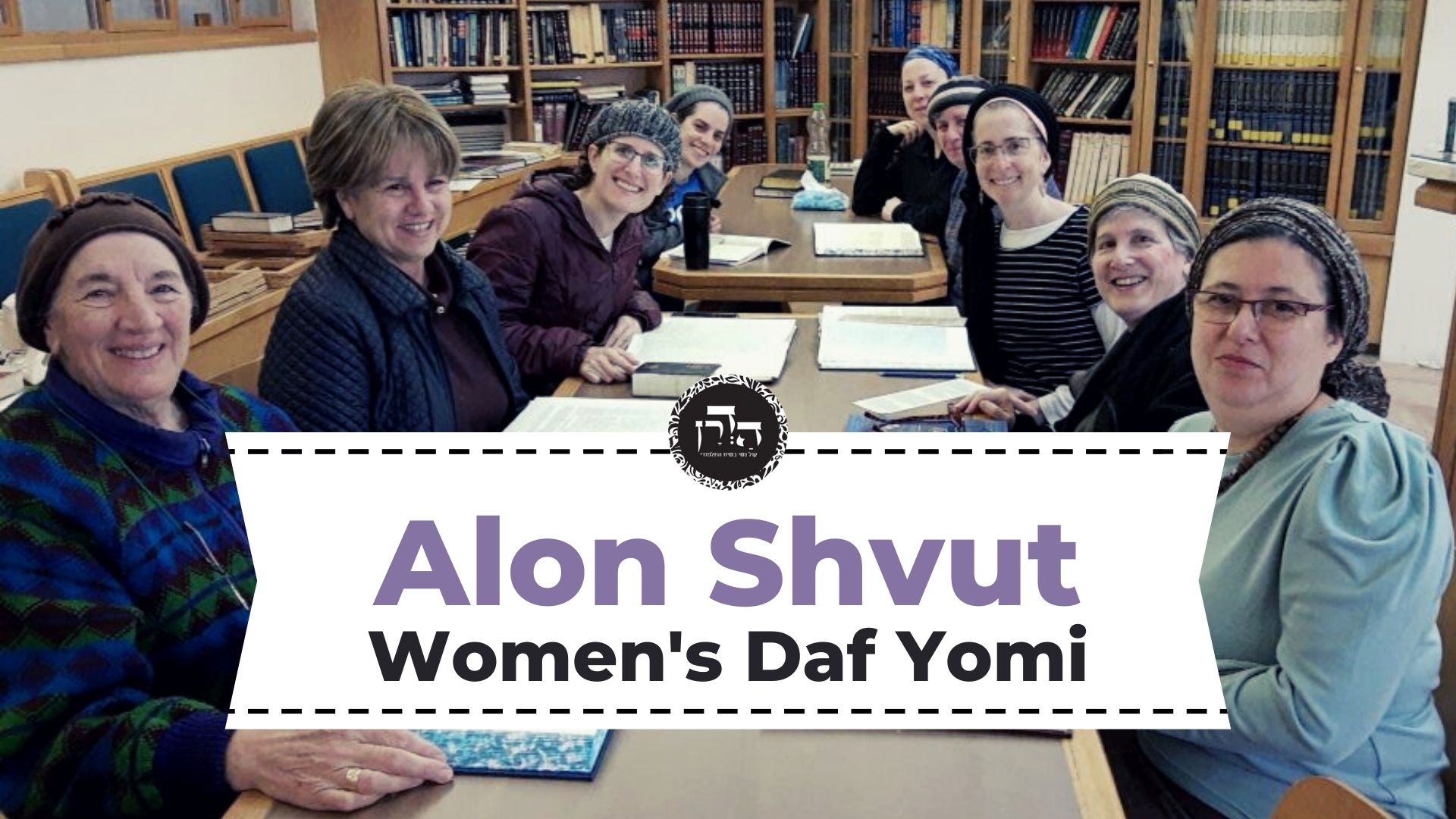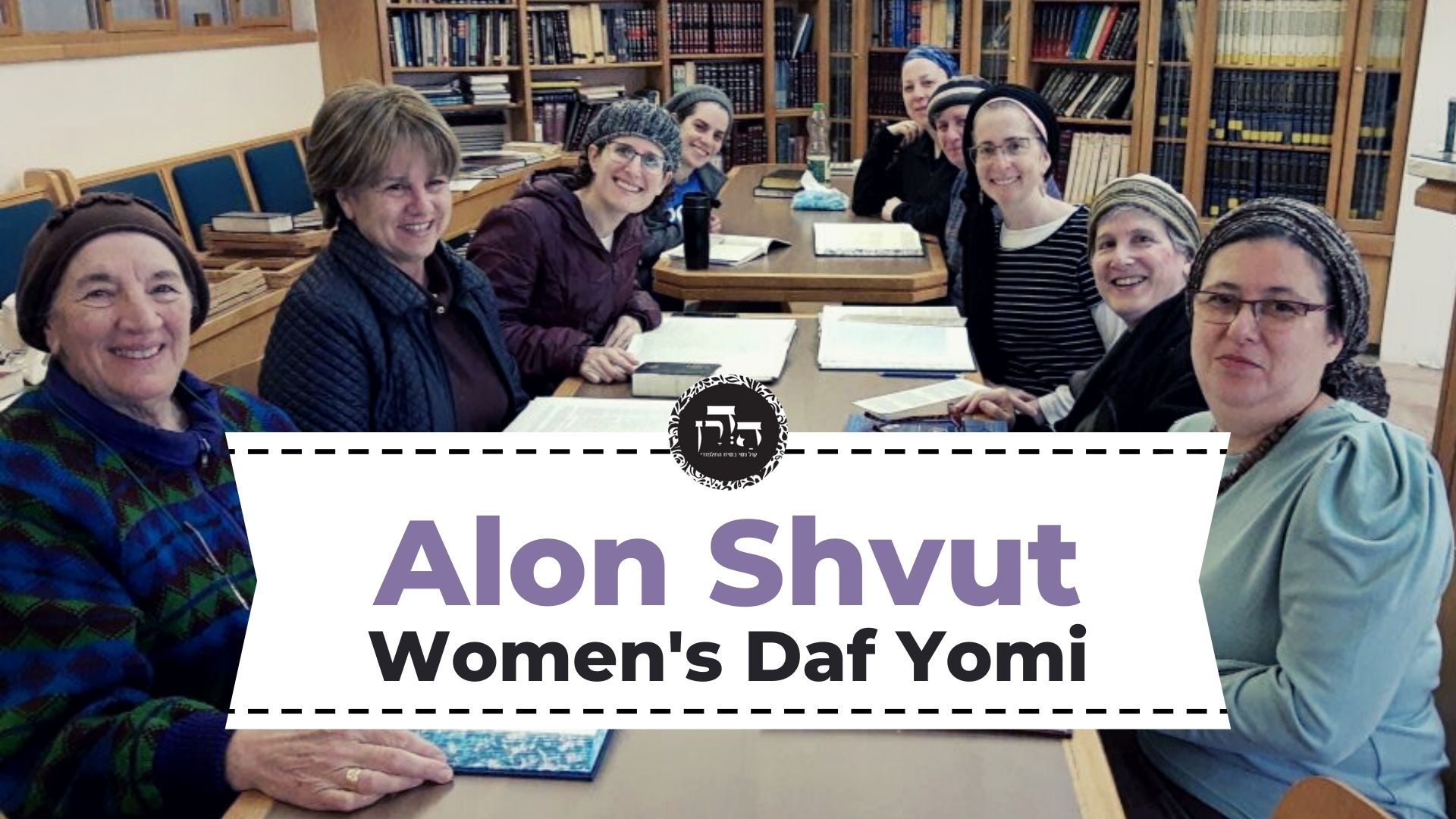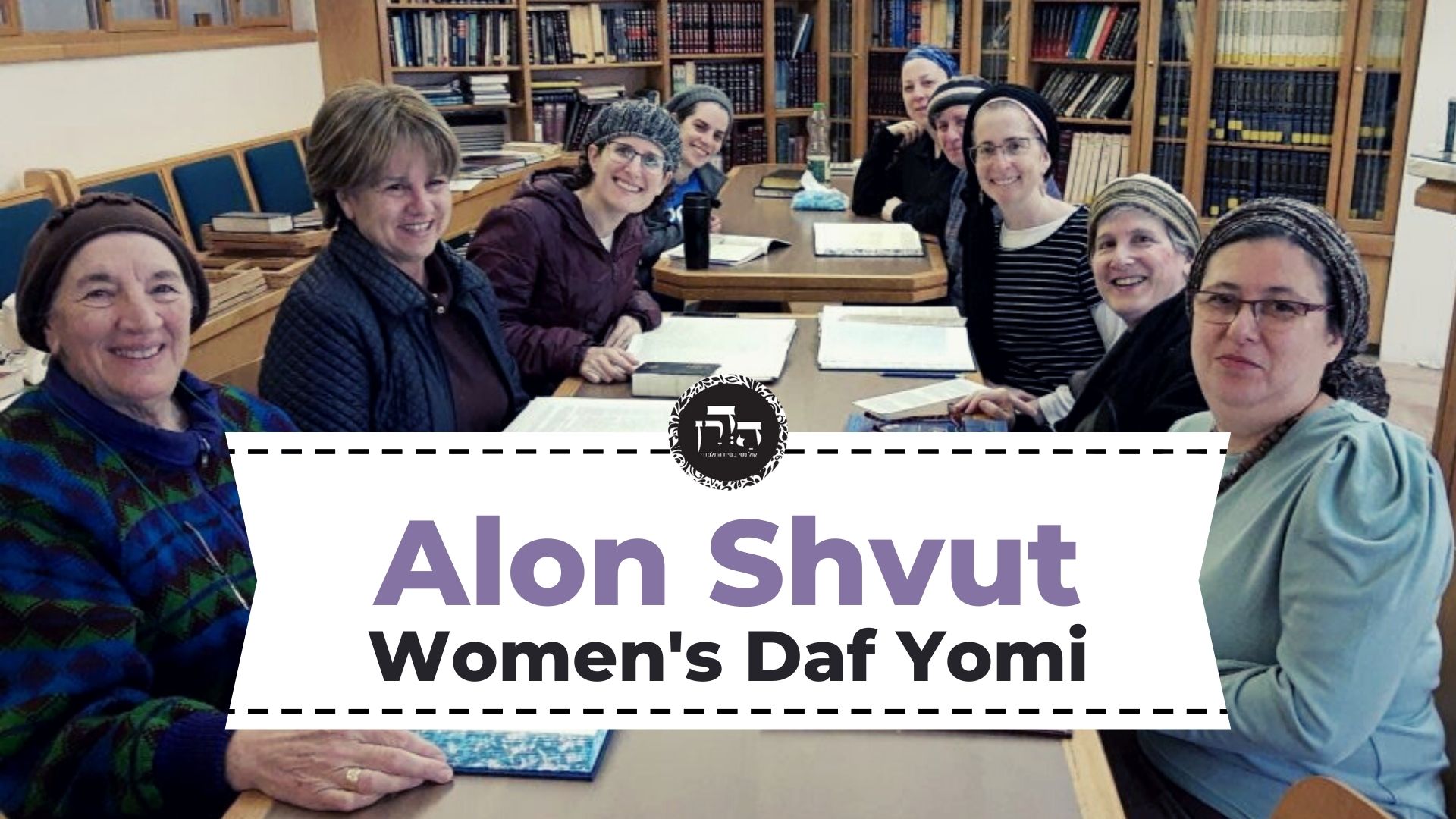Eruvin 25
מַאן דְּשָׁרֵי — דְּהָא לֵיכָּא דָּיוֹרִין. וּמַאן דְּאָסַר — זִימְנִין דְּהָוֵי בַּהּ דָּיוֹרִין וְאָתֵי לְטַלְטוֹלֵי.
The Sage who permits doing so holds that it is permitted since in the yard itself there are no residents, and a place without residents cannot prohibit carrying in another, adjacent domain. And the Sage who prohibits doing so holds that it is prohibited because sometimes there are residents in it who can prohibit carrying in the other domain, and people might unwittingly come to carry from the yard to the town in their usual manner, even though it is prohibited.
קַרְפֵּף יוֹתֵר מִבֵּית סָאתַיִם שֶׁלֹּא הוּקַּף לְדִירָה וּבָא לְמַעֲטוֹ, מִיעֲטוֹ בָּאִילָנוֹת — לָא הָוֵי מִיעוּט.
With regard to a karpef that measures more than two beit se’a and that had not been fenced in from the outset for the purpose of residence, and one came to reduce its size, if he reduced it by planting trees in a section of the space, it is not a valid reduction, because trees are commonly found in a karpef designed for dwelling; therefore, they are not considered something out of the ordinary that would reduce its size.
בָּנָה בּוֹ עַמּוּד גָּבוֹהַּ עֲשָׂרָה וְרָחָב אַרְבָּעָה — הָוֵי מִיעוּט. פָּחוֹת מִשְּׁלֹשָׁה — לָא הָוֵי מִיעוּט. מִשְּׁלֹשָׁה וְעַד אַרְבָּעָה — רַבָּה אָמַר: הָוֵי מִיעוּט, וְרָבָא אָמַר: לָא הָוֵי מִיעוּט.
But if he built up a column ten handbreadths high and four handbreadths wide, it is an effective reduction, i.e., if the karpef is thereby reduced to the area of two beit se’a, one is permitted to carry within it. However, if the column is less than three handbreadths wide, it is not an effective reduction. And if it is between three to four handbreadths wide, there is a dispute between amora’im. Rabba said: It constitutes an effective reduction, and Rava said: It does not constitute an effective reduction.
רַבָּה אָמַר: הָוֵי מִיעוּט, דְּהָא נָפֵיק לֵיהּ מִתּוֹרַת לָבוּד. רָבָא אָמַר: לָא הָוֵי מִיעוּט, כֵּיוָן דְּלָא הָוֵי מְקוֹם אַרְבָּעָה — לָא חֲשִׁיב.
The Gemara explains the two opinions. Rabba said that it constitutes an effective reduction because it is large enough to be excluded from the principle of lavud, namely, that solid surfaces with gaps between them less than three handbreadths are considered joined. Since the column stands independently, it reduces the size of the karpef. Rava said that it does not constitute a valid reduction because as it is not a place of at least four handbreadths, it is not significant. An area of less than four handbreadths is not considered independent.
הִרְחִיק מִן הַכּוֹתֶל אַרְבָּעָה וְעָשָׂה מְחִיצָה — הוֹעִיל. פָּחוֹת מִשְּׁלֹשָׁה — לֹא הוֹעִיל. מִשְּׁלֹשָׁה וְעַד אַרְבָּעָה — רַבָּה אָמַר: הוֹעִיל, רָבָא אָמַר: אֵינוֹ מוֹעִיל.
It was further stated: If one distanced himself four handbreadths from the wall of the karpef and erected an additional partition for the sake of dwelling, it is effective in permitting one to carry in the fenced-off inner area. But if the distance is less than three handbreadths, it is not effective, as the new wall is considered attached to the first by means of the principle of lavud, and it is like one partition built on top of another. And if the distance is between three to four handbreadths, that is the topic of the dispute among the amora’im, in which Rabba said: It is effective, and Rava said: It is not effective.
רַבָּה אָמַר: הוֹעִיל, דְּהָא נָפֵיק לֵיהּ מִתּוֹרַת לָבוּד. רָבָא אָמַר: אֵינוֹ מוֹעִיל, כֵּיוָן דְּלָא הָוֵי מְקוֹם אַרְבָּעָה, לָא חֲשִׁיב.
The Gemara explains the two opinions. Rabba said: It is effective, as it is far enough away to be removed from the principle of lavud. Rava disagreed and said: It is not effective, because as it is not a place of at least four handbreadths, it is not significant.
רַב שִׁימִי מַתְנֵי לְקוּלָּא: טָח בּוֹ טִיט וְיָכוֹל לַעֲמוֹד בִּפְנֵי עַצְמוֹ — הָוֵי מִיעוּט. אֵינוֹ יָכוֹל לַעֲמוֹד בִּפְנֵי עַצְמוֹ — רַבָּה אָמַר: הָוֵי מִיעוּט, רָבָא אָמַר: לָא הָוֵי מִיעוּט.
Rav Simi would teach a more lenient version of the dispute between Rabba and Rava. If one plastered the walls of a karpef larger than two beit se’a with plaster, and the plaster can stand on its own, all agree that it is an effective reduction, as it is considered as if he has made a new partition. But if the plaster cannot stand on its own, and it only stays in place because it is attached to the existing wall, there is an amoraic dispute in which Rabba said: It is an effective reduction, and Rava said: It is not an effective reduction.
רַבָּה אָמַר: הָוֵי מִיעוּט, הַשְׁתָּא מִיהָא קָאֵי. רָבָא אָמַר: לָא הָוֵי מִיעוּט, כֵּיוָן דְּלָא יָכוֹל לְמֵיקַם בִּפְנֵי עַצְמוֹ, לֹא כְּלוּם הוּא.
The Gemara explains the two opinions. Rabba says: It is an effective reduction, because for now, in any case, it stands. Rava says: It is not an effective reduction, because as it cannot stand on its own, it is nothing, i.e., it is insignificant.
הִרְחִיק מִן הַתֵּל אַרְבָּעָה וְעָשָׂה מְחִיצָה — הוֹעִיל.
If one distanced himself four handbreadths from a mound ten handbreadths high that stands in a karpef larger than two beit se’a, and he erected a partition for the sake of dwelling, it is effective to permit one to carry.
פָּחוֹת מִשְּׁלֹשָׁה אוֹ עַל שְׂפַת הַתֵּל, רַב חִסְדָּא וְרַב הַמְנוּנָא, חַד אָמַר: הוֹעִיל, וְחַד אָמַר: לֹא הוֹעִיל.
But if he erected the partition less than three handbreadths from the mound or on the edge of the mound itself, so that it is like a partition built on top of another partition, this is a dispute between Rav Ḥisda and Rav Hamnuna. One of them said: It is effective, and the other one said: It is not effective.
תִּסְתַּיֵּים דְּרַב חִסְדָּא אָמַר הוֹעִיל, דְּאִתְּמַר: הָעוֹשֶׂה מְחִיצָה עַל גַּבֵּי מְחִיצָה, אָמַר רַב חִסְדָּא: בְּשַׁבָּת הוֹעִיל.
The Gemara seeks to clarify which of the Sages held which opinion. Conclude that it was Rav Ḥisda who said it is effective, for it was stated that the amora’im disagreed about the following: If one erected a partition on top of an existing partition, Rav Ḥisda said: With regard to the halakhot of Shabbat, e.g., if the first partition was not erected for the purpose of residence, the second partition is effective.
בְּנִכְסֵי הַגֵּר לֹא קָנָה.
However, with regard to the property of a convert, he does not acquire it. The property of a convert who dies without heirs is regarded as ownerless unless he had transferred it to someone as a gift during his lifetime. Whoever first implements a valid mode of acquisition upon such property acquires it. For example, one may acquire property by performing an act of taking possession, such as construction of a partition around it. But if one erects a partition around the property of a deceased convert on top of an existing partition, he does not acquire the property in this manner.
וְרַב שֵׁשֶׁת אָמַר: אַף בְּשַׁבָּת נָמֵי לֹא הוֹעִיל. תִּסְתַּיֵּים.
And Rav Sheshet said: Even with regard to Shabbat it is not effective. The Gemara comments: Indeed, conclude that it is Rav Ḥisda who maintains that one partition built on top of another is effective for Shabbat.
אָמַר רַב חִסְדָּא: וּמוֹדֶה לִי רַב שֵׁשֶׁת שֶׁאִם עָשָׂה מְחִיצָה עַל הַתֵּל — שֶׁהוֹעִיל.
Rav Ḥisda said: Rav Sheshet agrees with me that if one erected a partition on the mound, rather than merely adjacent to it, that it is effective to permit one to carry on the mound itself, even though, according to him, it is prohibited to carry in the rest of the karpef.
מַאי טַעְמָא, הוֹאִיל וּבַאֲוִיר מְחִיצוֹת הָעֶלְיוֹנוֹת הוּא דָּר.
What is the reason for this? Since he dwells in the space between the upper partitions, he utilizes these new partitions and they serve a function. Although in relation to one positioned below the mound these are partitions built on top of the pre-existing partitions of the mound, and therefore they do not allow him to carry in the karpef, they are nonetheless effective in allowing him to carry on the mound itself.
בָּעֵי רַבָּה בַּר בַּר חָנָה: נִבְלְעוּ מְחִיצוֹת הַתַּחְתּוֹנוֹת, וְהָעֶלְיוֹנוֹת קַיָּימוֹת, מַהוּ?
Rabba bar bar Ḥana raised a dilemma: If the lower partitions were swallowed up, e.g., if they sank in boggy ground, and the upper partitions that he had erected still stand, what is the law?
לְמַאי? אִי לְנִכְסֵי הַגֵּר, הַיְינוּ דְּיִרְמְיָה בִּירָאָה. דְּאָמַר יִרְמְיָה בִּירָאָה אָמַר רַב יְהוּדָה: הַאי מַאן דִּשְׁדָא לִיפְתָּא אַפִּילָא דְּאַרְעָא דְגֵר, וַאֲתָא יִשְׂרָאֵל אַחֲרִינָא רְפַק בָּהּ פּוּרְתָּא — בָּתְרָא קָנֵי, קַמָּא לָא קָנֵי.
The Gemara asks: With regard to what issue was this dilemma raised? If it was raised with regard to acquiring the property of a convert, this is precisely the same as the ruling cited by Yirmeya Bira’a, as Yirmeya Bira’a said that Rav Yehuda said: If one sowed turnip seeds in cracks which he found in land that had belonged to a convert, and another Jew came and plowed the ground a little, the latter one, the one who plowed, acquires the property, and the first one does not acquire it.
מַאי טַעְמָא? בְּעִידָּנָא דִּשְׁדָא — לָא קָא שָׁבַח. כִּי קָא שָׁבְחָא — מִמֵּילָא קָא מְשַׁבְּחָא.
What is the reason that the first one who sowed the seeds does not acquire the property? At the time that he sowed, the land was not improved by his sowing. When it did improve, with the growth of the turnips, it improved on its own. That is to say, the act of sowing alone is not a sufficiently noticeable action that changes and improves the property at the time. Although the sowing later proves to have been beneficial, this is seen as an improvement of the land that comes on its own. Therefore, an action that will only provide benefit in the future cannot serve as an act of acquisition.
וְאֶלָּא לְעִנְיַן שַׁבָּת, הָוֵי מְחִיצָה הַנַּעֲשֶׂה בְּשַׁבָּת.
Rather, you must say that the dilemma was raised with respect to Shabbat, in which case it is a partition that was made on Shabbat; beforehand it was not a valid partition, and the upper ones acquired the status of a partition only after the lower partitions sank into the ground.
וְתַנְיָא: כׇּל מְחִיצָה הַנַּעֲשֶׂה בְּשַׁבָּת, בֵּין בְּשׁוֹגֵג בֵּין בְּמֵזִיד — שְׁמָהּ מְחִיצָה.
And it was already taught in a baraita: Any partition made on Shabbat, whether unwittingly or intentionally, is called a valid partition. Consequently, the upper partitions should be regarded as valid partitions that allow one to carry in the karpef.
לָאו אִיתְּמַר עֲלַהּ, אָמַר רַב נַחְמָן: לֹא שָׁנוּ אֶלָּא לִזְרוֹק, אֲבָל לְטַלְטֵל — אָסוּר.
The Gemara raises a difficulty: Wasn’t it stated about this law that Rav Naḥman said: They taught that such a partition is called a partition only as a stringency, in that it is prohibited to throw from an area enclosed by such a partition into the public domain and vice versa; but to carry within it as a full-fledged private domain is prohibited. This implies that these are not proper partitions.
כִּי אִיתְּמַר דְּרַב נַחְמָן — אַמֵּזִיד אִיתְּמַר.
The Gemara refutes this objection: When that statement of Rav Naḥman was stated, it was stated with regard to a case where one erected the partition intentionally. Since one intentionally violated Shabbat when he erected the partition, the Sages imposed a penalty that he is prohibited to carry within the enclosed area. But if the partition was made unwittingly or came about by itself, no such penalty was imposed, and one is permitted to carry.
הָהִיא אִיתְּתָא דַּעֲבַדָה מְחִיצָה עַל גַּבֵּי מְחִיצָה בְּנִכְסֵי הַגֵּר. אֲתָא הָהוּא גַּבְרָא, רְפַק בָּהּ פּוּרְתָּא. אֲתָא לְקַמֵּיהּ דְּרַב נַחְמָן, אוֹקְמַהּ בִּידֵיהּ. אֲתַא[י] אִיהִי וְקָא צָוְוחָא קַמֵּיהּ. אֲמַר לַהּ: מַאי אֶיעְבֵּיד לָךְ, דְּלָא מַחְזְקַתְּ כִּדְמַחְזְקִי אִינָשֵׁי.
The Gemara cites a related incident: A certain woman erected a partition on top of another partition in the property of a deceased convert. A certain man then came and plowed the ground a little. The man came before Rav Naḥman, who established the property in his possession. The woman then came and cried out before Rav Naḥman. He said to her: What can I do for you, as you did not take possession of the property in the manner that people take possession.
קַרְפֵּף בֵּית שָׁלֹשׁ וְקֵירָה בּוֹ בֵּית סְאָה. רָבָא אָמַר: אֲוִיר קֵירוּיוֹ מְיַיתְּרוֹ. וְרַבִּי זֵירָא אָמַר: אֵין אֲוִיר קֵירוּיוֹ מְיַיתְּרוֹ.
With regard to a karpef the size of three beit se’a, and one roofed one beit se’a of it, the amora’im disputed whether or not the area of karpef is two beit se’a, in which case it is permitted to carry there, or three beit se’a, in which case it would be prohibited. Rava said: Its roofed space renders it in excess of two beit se’a, meaning that the roofed area is not considered separate from the rest, and so it is prohibited to carry in the karpef. And Rabbi Zeira said: Its roofed space does not render it in excess of two beit se’a, and it is permitted to carry there.
לֵימָא רָבָא וְרַבִּי זֵירָא בִּפְלוּגְתָּא דְּרַב וּשְׁמוּאֵל קָא מִיפַּלְגִי. דְּאִיתְּמַר: אַכְסַדְרָה בְּבִקְעָה, רַב אָמַר: מוּתָּר לְטַלְטֵל בְּכוּלָּהּ, וּשְׁמוּאֵל אָמַר: אֵין מְטַלְטְלִין אֶלָּא בְּאַרְבַּע אַמּוֹת.
The Gemara comments: Let us say that Rava and Rabbi Zeira dispute the same point that was the subject of dispute between Rav and Shmuel. These amora’im disagreed about the following, as it was stated: With regard to an enclosed veranda [akhsadra], which is a roofed structure without walls or with incomplete walls, in a field that has the status of a karmelit, Rav said: One is permitted to carry in the entire enclosed veranda, as it is considered a private domain. And Shmuel said: One may carry only a distance of four cubits.
רַב אָמַר: מוּתָּר לְטַלְטֵל בְּכוּלָּהּ — אָמְרִינַן פִּי תִקְרָה יוֹרֵד וְסוֹתֵם. וּשְׁמוּאֵל אָמַר: אֵין מְטַלְטְלִין אֶלָּא בְּאַרְבַּע אַמּוֹת — לָא אָמְרִינַן פִּי תִקְרָה יוֹרֵד וְסוֹתֵם.
The Gemara explains the two opinions: Rav said: One is permitted to carry in the entire enclosed veranda, since we say that the edge of the roof descends to the ground and closes up the enclosed veranda on all sides; consequently, it is considered a separate private domain. And Shmuel said: One may carry only a distance of four cubits, as we do not say that the edge of the roof descends and closes up the enclosed veranda.
אִי דַּעֲבִידָא כִּי אַכְסַדְרָה הָכִי נָמֵי. הָכָא בְּמַאי עָסְקִינַן, דְּעַבְדַהּ כִּי אוּרְזִילָא.
The Gemara rejects this argument: If the roof in the covered section of the karpef were made like an enclosed veranda whose roof is level, indeed, both Rava and Rabbi Zeira would agree that the edge of the roof descends to the ground and closes up the area. With what are we dealing here? We are dealing with a case where the roof is made like a hammock, i.e., slanted, and therefore one cannot say that the edge of the roof descends to the ground and encloses the area.
אָמַר רַבִּי זֵירָא: וּמוֹדֵינָא בְּקַרְפֵּף שֶׁנִּפְרַץ בִּמְלוֹאוֹ לֶחָצֵר שֶׁאָסוּר. מַאי טַעְמָא? הוֹאִיל וַאֲוִיר חָצֵר מְיַיתְּרוֹ.
Rabbi Zeira said: I agree with Rava with regard to a karpef that is fully breached into a courtyard, meaning the entire wall between them is breached, that it is prohibited to carry in it. What is the reason for this? Because the additional space of the courtyard joins to the karpef and renders it in excess of two beit se’a. Consequently, it is prohibited to carry in it.
מַתְקֵיף לַהּ רַב יוֹסֵף: וְכִי אֲוִיר הַמּוּתָּר לוֹ אוֹסְרוֹ?
Rav Yosef strongly objects to this explanation: Does a space in which it is permitted to carry, the courtyard, render the karpef, prohibited? Given that it had been permitted beforehand to carry from the courtyard to the karpef, why say that now that the partition between them is breached, the additional space, which was itself permitted, should render it prohibited to carry in the karpef?
אֲמַר לֵיהּ אַבָּיֵי: כְּמַאן, כְּרַבִּי שִׁמְעוֹן? לְרַבִּי שִׁמְעוֹן נָמֵי, הָא אִיכָּא אֲוִיר מְקוֹם מְחִיצוֹת.
Abaye said to him: In accordance with whose opinion do you say this? Apparently, it is in accordance with the opinion of Rabbi Shimon, who holds that one is permitted to carry from a courtyard to a karpef. But even according to Rabbi Shimon, there is the space where the walls that are now breached had once stood. This space had not been fit for carrying from the outset, even according to Rabbi Shimon; therefore, if the karpef had been at first exactly the area of two beit se’a, it would be prohibited to carry in the entire karpef due to the additional space of the fallen walls.
דְּאָמַר רַב חִסְדָּא: קַרְפֵּף שֶׁנִּפְרַץ בִּמְלוֹאוֹ לְחָצֵר — חָצֵר מוּתֶּרֶת וְקַרְפֵּף אָסוּר.
This is as Rav Ḥisda said with regard to a karpef that is fully breached into a courtyard: In the courtyard one is permitted to carry and in the karpef he is prohibited to carry.
חָצֵר מַאי טַעְמָא? דְּאִית לֵיהּ גִּיפּוּפֵי? וְהָא זִמְנִין דְּמַשְׁכַּחַתְּ לַהּ אִיפְּכָא.
The Gemara asks: As for the courtyard, what is the reason that this is permitted? Is it because it has the remnants of the original walls on either side of the breach, which allow the breach to be treated like an entrance? But at times you find just the opposite; if the courtyard was narrower than the karpef and the partition between them was fully breached, it is the karpef that retains the remnants of the original walls on either side of the breach, while the courtyard is breached in its entirety.
אֶלָּא, מִשּׁוּם דְּאָמְרִינַן: זֶה — אֲוִיר מְחִיצוֹת מְיַיתְּרוֹ, וְזֶה — אֵין אֲוִיר מְחִיצוֹת מְיַיתְּרוֹ.
Rather, it is because we say that with regard to this one, the karpef, which was not enclosed for the purpose of residence and where one is permitted to carry only if it is no more than two beit se’a, the space of the fallen walls renders it in excess of two beit se’a. However, with regard to that one, the courtyard, which was enclosed for the purpose of residence and where there is no size limit above which it is prohibited to carry, the space of the fallen walls does not render it in excess of any limit.
הָהוּא בּוּסְתָּנָא דַּהֲוָה סְמִיךְ לְגוּדָּא דְּאַפַּדְנָא. נְפַל אֲשִׁיתָא בָּרַיְיתָא דְּאַפַּדְנָא. סָבַר רַב בִּיבִי לְמֵימַר לִיסְמוֹךְ אַגּוּדָּא גַוּוֹיָאתָא.
The Gemara cites a related incident: A certain orchard [bustana] was adjacent to the wall of a mansion [apadna]. The orchard was larger than two beit se’a and was enclosed for the purpose of residence by a wall, part of which was the wall of the mansion. One day the outer wall of the mansion, which also served as a wall for the orchard, collapsed. Rav Beivai thought to say that we can rely upon one of the mansion’s inner walls to serve as a partition for the orchard and thereby permit one to carry there in the future as well.
אֲמַר לֵיהּ רַב פַּפִּי: מִשּׁוּם דְּאַתּוּ מִמּוּלָאֵי אָמְרִיתוּ מִילֵּי מוּלְיָיאתָא. הָנָךְ מְחִיצוֹת, לְגַוַּאי — עֲבִידָן, לְבָרַאי — לָא עֲבִידָן.
Rav Pappi said to him: Because you come from truncated [mula’ei] people, as Rav Beivai’s family traced their lineage to the house of Eli, all of whose descendants were destined to be short-lived (see i Samuel 2:31), you speak truncated [mulayata] matters, as the inner wall cannot be relied upon at all. That is because these walls were made for the inside of the mansion, and they were not made for the outside; that is, they were not designed from the outset to serve as partitions for the orchard.
הָהִיא אַבְּווֹרַנְקָא דַּהֲוָה לֵיהּ לְרֵישׁ גָּלוּתָא בְּבוּסְתָּנֵיהּ. אֲמַר לֵיהּ לְרַב הוּנָא בַּר חִינָּנָא: לֶיעְבֵּיד מָר תַּקַּנְתָּא, דְּלִמְחַר נֵאכוּל נַהֲמָא הָתָם.
The Gemara relates: The Exilarch had a banqueting pavilion [abvarneka] in his orchard that was larger than two beit se’a and that had not been enclosed from the outset for the purpose of residence. The Exilarch said to Rav Huna bar Ḥinnana: Let the Master make some arrangement so that tomorrow, on Shabbat, we may eat bread there, i.e., so that we may be permitted to carry food and utensils from the house to the pavilion via the orchard.
אֲזַל עֲבַד קָנֶה קָנֶה פָּחוֹת מִשְּׁלֹשָׁה, אֲזַל רָבָא
Rav Huna bar Ḥinnana went and erected a fence of reeds, each reed separated from the next by less than three handbreadths. That is to say, he erected two such partitions between the house and the pavilion with a passageway between them, through which the Exilarch and his men could carry whatever they needed, as the partitions were constructed in the proper manner for the purpose of residence. Rava, however, went




